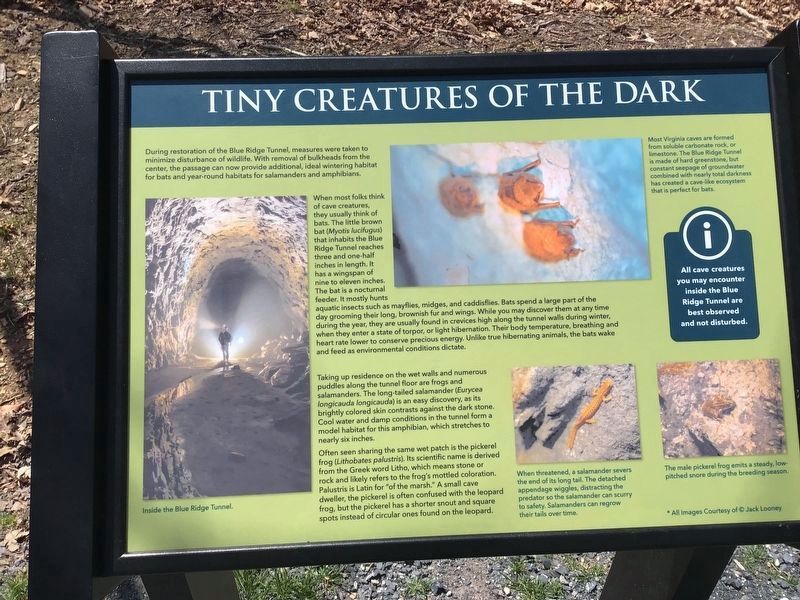Near Afton in Augusta County, Virginia — The American South (Mid-Atlantic)
Tiny Creatures Of The Dark
When most folks think of cave creatures, they usually think of bats. The little brown bat (Myotis lucifugus) that inhabits the Blue Ridge Tunnel reaches three and one-half inches in length. It has a wingspan of nine to eleven inches. The bat is a nocturnal feeder. It mostly hunts aquatic insects such as mayflies, midges, and caddisflies. Bats spend a large part of the day grooming their long, brownish fur and wings. While you may discover them at any time during the year, they are usually found in crevices high along the tunnel walls during winter, when they enter a state of torpor, or light hibernation. Their body temperature, breathing and heart rate lower to conserve precious energy. Unlike true hibernating animals, the bats wake and feed as environmental conditions dictate.
Taking up residence on the wet walls and numerous puddles along the tunnel floor are frogs and salamanders. The long-tailed salamander (Eurycea longicauda longicauda) is an easy discovery, as its brightly colored skin contrasts against the dark stone. Cool water and damp conditions in the tunnel form a model habitat for this amphibian, which stretches to nearly six inches.
Often seen sharing the same wet patch is the pickerel frog (Lithobates palustris). Its scientific name is derived from the Greek word Litho, which means stone or rock and likely refers to the frog’s mottled coloration. Palustris is Latin for “of the marsh.” A small cave dweller, the pickerel is often confused with the leopard frog, but the pickerel has a shorter snout and square spots instead of circular ones found on the leopard.
(captions)
Inside the Blue Ridge Tunnel
Most Virginia caves are formed from soluble carbonate rock, or limestone. The Blue Ridge Tunnel is made of hard greenstone, but constant seepage of groundwater combined with nearly total darkness has created a cave-like ecosystem that is perfect for bats.
When threatened, a salamander severs the end of it’s long tail. The detached appendage wiggles, distracting the predator so the salamander can scurry to safety. Salamanders can regrow their tails over time.
The male pickerel frog emits a steady, low-pitched snore during the breeding season.
*All images courtesy of Jack Looney
Topics. This historical marker is listed in these topic lists: Animals • Environment • Parks & Recreational Areas • Railroads & Streetcars.
Location. 38° 2.555′ N, 78° 51.762′ W. Marker is near Afton, Virginia, in Augusta County. Marker can be reached from Three Notched Mountain Highway (U.S. 250) 0.8 miles north of Interstate 64, on the left when traveling west. Located along the westen end of the Blue Ridge Tunnel Trail. Touch for map. Marker is at or near this postal address: 483 Three Notched Mountain Hwy, Waynesboro VA 22980, United States of America. Touch for directions.
Other nearby markers. At least 8 other markers are within walking distance of this marker. West Side Features Then & Now (about 300 feet away, measured in a direct line); They Died Building the Railroad (about 700 feet away); Dr. Robert Sumter Griffith (approx. 0.2 miles away); Problems & Solutions (approx. 0.2 miles away); West Trailhead (approx. 0.3 miles away); Rockfish Gap (approx. half a mile away); Park-to-Park Beauty (approx. ¾ mile away); Welcome to Shenandoah National Park (approx. ¾ mile away). Touch for a list and map of all markers in Afton.
Also see . . . Claudius Crozet Blue Ridge Tunnel Foundation. (Submitted on April 26, 2022.)
Credits. This page was last revised on April 26, 2022. It was originally submitted on April 25, 2022, by Adan Flores of Spring Hope. This page has been viewed 230 times since then and 54 times this year. Photo 1. submitted on April 25, 2022, by Adan Flores of Spring Hope. • Bernard Fisher was the editor who published this page.
Editor’s want-list for this marker. Wide shot of marker and its surroundings. • Can you help?
